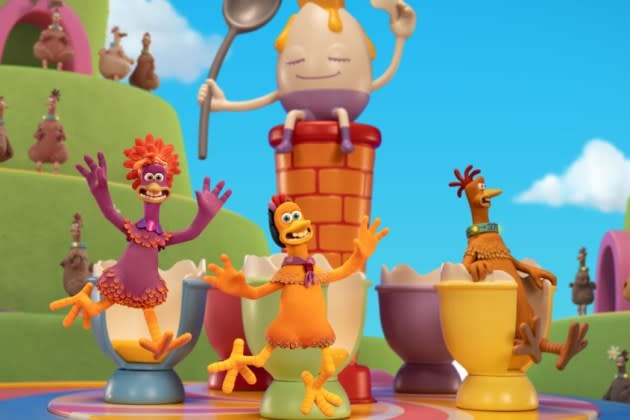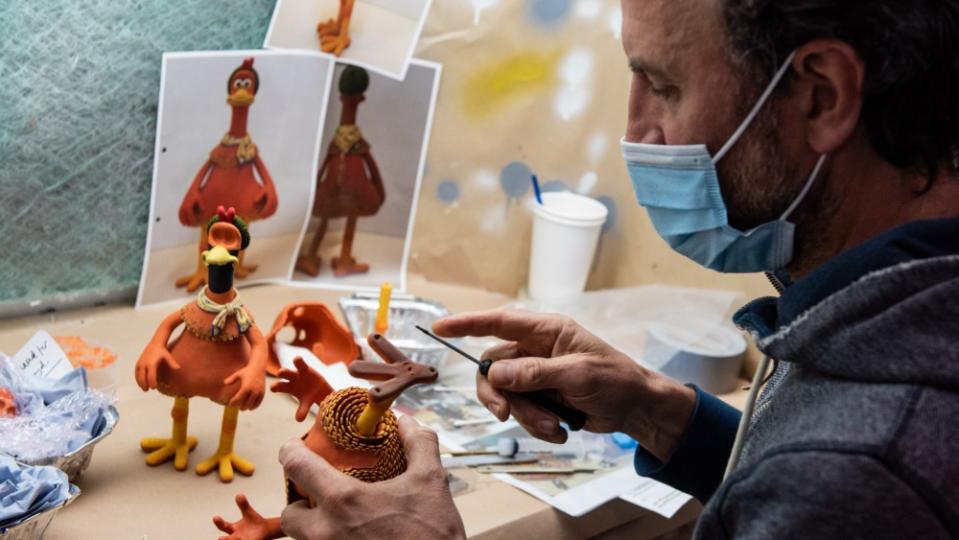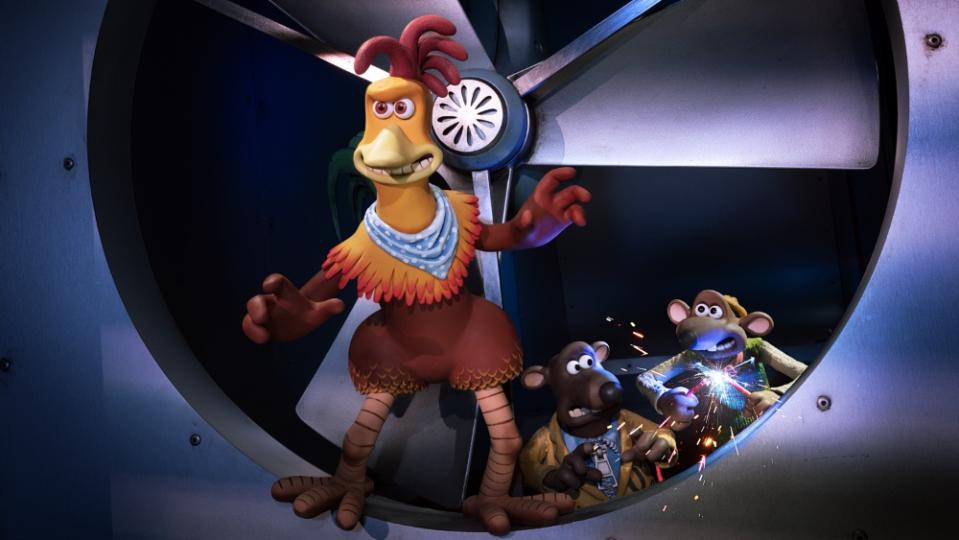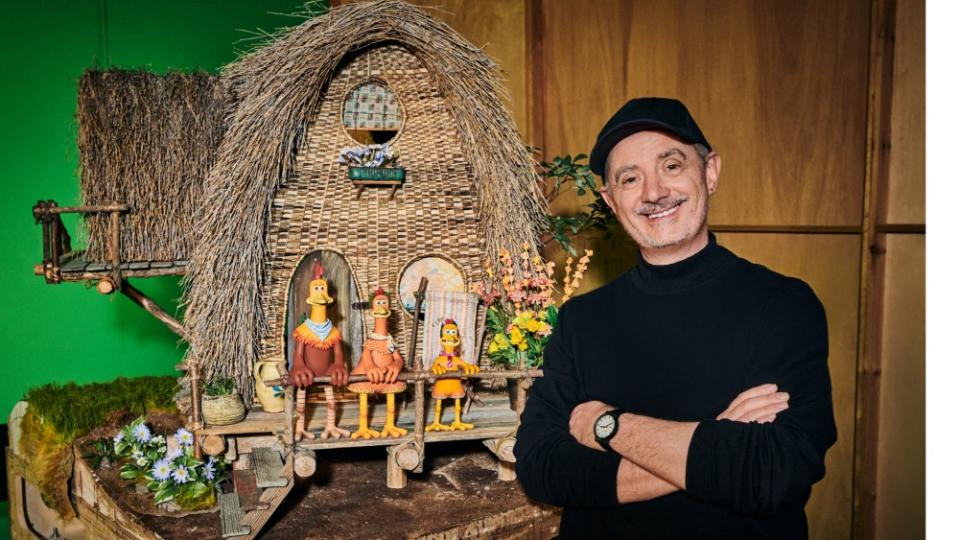Inside the Making of ‘Chicken Run: Dawn of the Nugget’: How Aardman Battled Fire, Flooding and a Potential Clay Drought to Make the Stop Motion Sequel

The chickens in “Chicken Run: Dawn of the Nugget” are sweet. Not just to look at, with their wide eyes and goofy grins, but literally: if you licked the palm-sized clay and silicone bird models they’d taste like sugar. Which makes sense, because they’re coated in it.
The puppet makers at Aardman Animations, the stop motion studio behind the film, used to dust the chickens with silica powder to prevent them from looking too shiny on camera — but silica is toxic and requires protective gear while handling. So one day, the team tried powdered sugar instead. It worked. “It just makes this perfect matte surface if you get it right,” says Aardman’s head of puppets Kate Anderson.
More from Variety
How 'The Crown' Shot Its Emotional Final Scenes With Imelda Staunton, Olivia Colman and Claire Foy
Pete Davidson Lands New Stand-Up Netflix Special to Premiere Next Month (EXCLUSIVE)
Co-opting a kitchen cupboard staple as a key ingredient in one of the most anticipated animated movies of the year is the kind of scrappy innovation that Aardman is known for. Founded by animators Peter Lord and David Spraxton in 1972, the studio originally focused on stop motion shorts and commercials, especially once “Wallace and Gromit” creator Nick Park joined the team. Making a full-length feature “seemed impossible for the longest time,” Lord says. “Disney was still the big beast.”

The original “Chicken Run” movie, which was released in 2000 in partnership with Dreamworks, changed all that, becoming the highest-grossing stop motion movie ever and putting Aardman firmly on the map. And yet, despite going on to make other feature films including “Shaun the Sheep Movie” and “Flushed Away,” for more than two decades there was no “Chicken Run” sequel.
That’s about to change. Following its world premiere at the BFI London Film Festival in October, “Chicken Run: Dawn of the Nugget” debuts on Netflix Dec. 15. But why did it take so long? “When we finished the first one, DreamWorks [co-founder] Jeffrey Katzenberg said, ‘What about a sequel?’” Lord recalls. “But I have to say, he said it very late in the day. We were not ready and we were exhausted as well, so we moved on to other things.”
The idea resurfaced every few years but never really came together until, as Lord puts it, “the stars aligned.” First Park, who directed “Chicken Run,” agreed to return as an executive producer while Karey Kirkpatrick, who wrote the screenplay, signed back on as the writer. Then Lord bumped into long-time Aardman collaborator and “ParaNorman” director Sam Fell at a party in 2016 and convinced him to helm the project.
As a young animator, Fell had contributed to one scene in the original “Chicken Run” (“They were running out of time and they were just pulling anybody in — and I was one of those anybodies,” he says) so boarding the sequel as the director, he admits, was “quite daunting.” “It is lodged in the culture somehow in a very deep and significant way,” he says of the first “Chicken Run” film. “It’s become a classic.”
The first film tells the story of Ginger, a rebellious British chicken who teams up with an American rooster called Rocky to break her brood out of the evil Mrs. Tweedy’s farm before they’re all turned into pies. “I still maintain it’s the best elevator pitch ever,” Lord says with a grin. “‘The Great Escape’ with chickens. It speaks of excitement and comedy and absurdity in equal measure.”

Whereas the first film saw the chickens breaking out, Fell’s idea for the sequel was to have them breaking in – this time to Mrs. Tweedy’s industrial chicken nugget factory after (spoiler alert) Ginger and Rocky’s daughter Molly accidentally ends up there. Thandiwe Newton voices Ginger, Zachary Levi plays Rocky and Bella Ramsey joins as Molly. Meanwhile cinematic references include “Mission Impossible,” “Logan’s Run,” “The Truman Show” and James Bond.
Given the scope of “Dawn of the Nugget” – and the fact it comes almost a quarter of a century after the first film – Fell and his team have embraced technology this time around. Now shots are worked out in pre-viz while production designer Darren Dubicki uses a VR headset to sculpt the sets, which are then reproduced IRL before being scanned back onto computers by the VFX team. The first film employed cumbersome 35mm cameras; today they’re digital (making it easier for the animators to maneuver around the sets) and fitted with tracking devices to enable virtual production.
And while the background birds in “Chicken Run” were mostly static because they were too small to be animated (“They were literally just stood there,” says supervising art director Matt Perry), in “Dawn of the Nugget” many of them are CG, especially in the Fun-Land scenes, the theme park Mrs Tweedy uses to distract the chickens before they’re turned into nuggets.
The chicken models, previously made entirely out of clay, have also benefited from a makeover. Like many of their Hollywood peers, they now boast silicon bodies, which are fitted over digitally designed, 3D-printed armatures (the heads and faces are still sculpted from clay). “It has got very, very high tech,” says Lord. “But I will absolutely maintain it’s a stop motion movie. Because all the stuff that you care about — love, laugh at — is stop motion.”
Wandering around Aardman’s vast Bristol studio, which is littered with tiny chicken-sized props and body parts, it’s immediately clear what he means. The feathers (known as “fluffles”) are still handpainted onto the chickens, with each model taking a week to decorate. It’s painstaking work, especially since animators require multiple models of each character (Ginger has the most, with 18 models on standby). And then, of course, they all need to be coated in powdered sugar.

The art department are equally resourceful. To create a tarmac road surface at model chicken scale the team use crushed walnuts mixed with glue and sand while a motorized device that looks like a toilet roll covered in tin foil has been jerry-rigged to create ripples on water. The thatched roofs at the beginning of the film are also made by hand, a skill the team had to learn after tracking down appropriately sized-material to ensure the straw was to scale. “For anything organic, I would avoid CGI like the plague,” Perry says of the natural landscapes.
Then there’s the stop motion animation process itself, which even the most advanced technology in the world can only speed up so much. During a set visit, Variety meets animator Tom Appshaw, who is trying to recreate a van driving up a hill frame by frame, an endeavor that requires him to defy the laws of gravity. “It’s an absolute nightmare because the van weighs a ton,” he says. It has taken him “a couple of days” to get three seconds’ worth of footage.
On another set, director mentee Suzy Parr is animating a sequence in which Ginger, trapped in Mrs. Tweedy’s mind control machine, is being brainwashed. Beside Parr is a set of fingernail-sized eyes painted with varying swirls which she swaps in and out of Ginger’s clay sockets every two frames. “It’s quite a low-tech method,” she explains. “We did look into doing it as CG, but it just felt like the effects look much more real doing [it this way].”
Fell says he wanted the film to be grounded in reality. Out of 1,500 shots, there’s only 20 that are fully VFX and the team had a rule that all the sets, even if they were partly computer generated, should theoretically be able to fit inside Aardman’s real-life studios. Fell confirms the Fun-Land set, one of the largest, could comfortably have been built inside Aardman’s reception. “We set boundaries and limits, otherwise it just gets too big and too infinite,” he says.
Despite the integration of tech, the team still faced a number of biblical challenges, including fire, flooding and drought. In 2005, an electrical fault in one of Aardman’s warehouses saw almost the company’s entire archive go up in flames. Only a few boxes with some solitary “Chicken Run” props and models remained (“There would be like, a leg and maybe Rocky’s head and some blueprint drawings,” Fell says) leaving the team to work largely from the film’s “Making of” book.
Then, halfway through, the studio sprung a number of leaks, causing production to halt temporarily (buckets and tubes got things going again). Finally, Aardman’s longtime clay supplier shut down earlier this year, leading to widespread reports the studio was going to “run out of clay.” Aardman declined to talk to Variety about the possible clay drought, but put out a statement reassuring fans “there is absolutely no need to worry. We have high levels of existing stocks of modeling clay to service current and future productions.”
With their traditional source of clay drying up, some studios may have taken the opportunity to get out of the stop motion game entirely. But not Aardman. “Stop motion is magic in the way that CG isn’t; with CG you can do anything and yet you have nothing that you can touch,” Lord says. “Whereas with a puppet, just about everyone has some notion of what it feels like to have a little character in your hand and give it life.”
Best of Variety
Sign up for Variety’s Newsletter. For the latest news, follow us on Facebook, Twitter, and Instagram.

